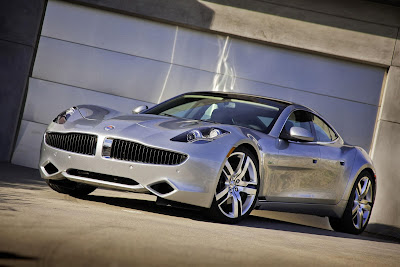Karma Automotive today launched its SC2 concept car during AutoMobility LA and the 2019 Los Angeles Auto Show. Featuring cutting-edge technology and design, SC2 is a bold demonstration of Karma's emergence as a high-tech mobility incubator, embodying world class luxury design and Karma IP.
"Karma's SC2 is a signpost to our future as a technology-driven brand. More than that, it previews our future design language, and is a thought-provoking expression of Karma's future Intellectual Property and product offerings," says Karma Automotive CEO Dr Lance Zhou. "Our open platform serves as a test bed for new technologies and partnerships, where we are to provide engineering, design, technology and customization resources others."
A striking full BEV concept, SC2 delivers an impressive 1,100 HP and advances from 0 to 60mph in under 1.9 seconds. Front and rear mounted twin electric motors deliver 800 kW peak power, with 10,500 lb.-ft (14,000 Nm) wheel torque. SC2 provides 350 miles of pure electric range, and is equipped with carbon ceramic brakes, a push-rod operated racing suspension and a Karma torque vectoring gearbox. An ultrasonic dynamic regenerative panel gives SC2 high performance handling and hand braking expected in an electric hyper car. The result is a vehicle as adept at navigating the tight curves and adrenaline-inducing straights of California's mountain, canyon and coastal regions as it suited to stun Hollywood's elite along Los Angeles's famed Rodeo Drive.
"SC2 presents an optimistic and bold message about Karma's future as we enthusiastically accept the challenge of elevating experience-driven mobility," says Karma VP, Global Design and Architecture, Andreas Thurner. "In creating SC2, we have enhanced the thrill of the open road through connected, interactive patented technology, beyond that of a traditional high-performance luxury vehicle."
Through Karma's one-of-a-kind Drive and Play® technology incorporated in SC2, automotive and gaming enthusiasts can re-live their previous drives through simulated driving experiences in their own vehicles. A triple high definition camera under the windshield and frequency-modulated continuous wave (FMCW) lidar sensors provide 360 capture of the car in motion, within a 3D environment. Simultaneously, SC2's intelligent technology captures the entire driving experience in real-time; turns, braking, acceleration, light simulations, sounds, air temperature and audio playlist. After the drive, SC2's adaptive laser projector replays the journey while the vehicle is parked, while a mounted smartphone acts as the cabin's rear-view mirror; transforming SC2 into a driving simulator where the user can re-experience their drive and fine-tune their skills. Drivers can then share their Drive and Play® experience with others, and also stream drivers' routes from around the world within their own vehicles, experiencing driving simulations at world-famous roads and race tracks.
"SC2's extreme design and proportions are expressive of Karma's unique intersections of technology, performance and luxury," says Thurner. "We challenged ourselves to design a street-ready hypercar concept, using Karma's in-house IP and components. Now, through Karma's open-platform, SC2's technology can be integrated into a variety of future vehicles."
SC2 embodies Karma's distinct design identity in its stance and surface. A bespoke Vapor Gray hand-painted body draws inspiration from the brand's sleek, technology-focused future, while optimized aerodynamics leads the exterior design. Generous length from front axle to windscreen remains a distinct Karma design characteristic, while patented articulating hinge winged doors gently rising upward and forward to reveal a fiber optic headliner and stunning silhouette. Inside SC2, an I-shaped 120kWh battery is housed in the center tunnel beneath the dashboard and seats.
Long-range radars, cameras, and FMCW lidar sensors throughout ready SC2 for a safe and realistic autonomous future, while Karma's Ultra Sonic Sensor Stalk technology supports launch control and regenerative braking, lending itself to a harmonious blend between regeneration and friction brakes. Vehicle entry is through fingerprint and facial recognition sensors. Inside the cabin, intelligent technology enhances the user experience: Biometric seats and steering wheel provide both control and comfort, 3D audio creates individual sound zones for driver and passenger, and electro chromatic glass shifts from clear to opaque for privacy and light sensitivity.
Beyond its growing technology story, Karma's current momentum is also driven by a period of rapid product introduction, including the U.S. launch of its 2020 Revero GT luxury electric vehicle, to be followed by a new Karma global platform in 2021 and supported by a rapidly increasing retail footprint.



